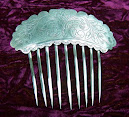I've discovered a few trends in my writing over the past five years. The majority of my tropes are second-chance romances; I write mostly as a pantster (loosely translated means I'm a person who writes by "the seat of her pants' as opposed to a plotter, or one who outlines her writing); and my heroes always, always insist on courting their ladies. So, when my hero--Lucas Harmon--in my Love Train release, 'Ainsley' sees a pair of hair combs with blue-colored stones reminding him of Ainsely's eyes, he knows they'd make the perfect courting gift.
While researching hair combs, I learned these fashion accessories date from earliest times and were created from wood, bones, ivory, feathers, and other natural materials. Sometimes they were embellished with gems or painted with designs. At first, they were flat in construction, but over time they evolved into curved pieces to better fit the shape of women's heads.
During the Victorian era, decorative combs came in handy for pinning into place the false hair needed to achieve the illusion of abundant tresses. By the Civil War, mass manufacturing meant the combs were often adorned with paste jewels, making them within the reach of almost every pocketbook. Large, straight combs, many in graceful fan shapes were the centerpiece, accompanied by smaller side and curved back combs. In coiffure lingo, four teeth or more made a comb a comb. Three teeth qualified as a "hair ornament", while two marked it as a "hair pin".


 Hair combs were one of the key items used to adorn women's coiffures and helped them achieve the popular upswept hairdos of the times. Their importance was noted in the 1862 edition of Godey's Lady's Book and Magazine.
Hair combs were one of the key items used to adorn women's coiffures and helped them achieve the popular upswept hairdos of the times. Their importance was noted in the 1862 edition of Godey's Lady's Book and Magazine."The hair is rolled over a cushion in front, and arranged in a waterfall at the back, round which is twisted a heavy plait. The comb is of black velvet and gilt. The coiffure is composed of a black barbe and lilies of the valley.
Plaits and puffs are also arranged with these combs in endless variety. When worn in the daytime, these small combs are made of light tortoise shell, with a row of small pearls. For the evening they are made of gold, either plain or studded with pearls, coral, steel, gilt, or even precious stones..."

Yet, the same publication encouraged readers to make their own.
"Fancy combs are still the rage, and very economical ones may be made by cutting a fancy design out of cardboard, such as knots, bows, linked rings, etc., and covering them with gilt, steel, or jet beads, and fastening them on a small plain comb."
Types of Hair Combs
Initially, combs were widely made of steel, gilt metal, brass, and other types of metals.
Tortoise shell has been used since ancient times. Its popularity began with the trend of the Spanish mantilla and would remain until it became scarce, being replaced by gutta-percha.
Although tortoiseshell and gutta-percha were popular, the most plentiful and popular material for hair combs throughout the 19th century was probably horn--partly because it was easy to find and cheaper than tortoiseshell. It was also extremely flexible, acting almost like plastic that could be easily cut, bent, stretched, pierced, or carved. Horn also easily lent itself to imitating the popular tortoiseshell pattern.
Decorative hair combs of the 19th century ranged from Gothic and Renaissance styles to Napoleonic and Oriental designs. Materials used to create combs also changed so quickly as the styles and what was popular one day was out of fashion the next.
Still...I'd like to believe that Ainsley will love the set of hair combs not only because they are beautiful but because Lucas gave them to her along with his love.
Ainsley - Book 8
Available for Pre-Order June 1st


 Hair combs were one of the key items used to adorn women's coiffures and helped them achieve the popular upswept hairdos of the times. Their importance was noted in the 1862 edition of Godey's Lady's Book and Magazine.
Hair combs were one of the key items used to adorn women's coiffures and helped them achieve the popular upswept hairdos of the times. Their importance was noted in the 1862 edition of Godey's Lady's Book and Magazine.












No comments:
Post a Comment